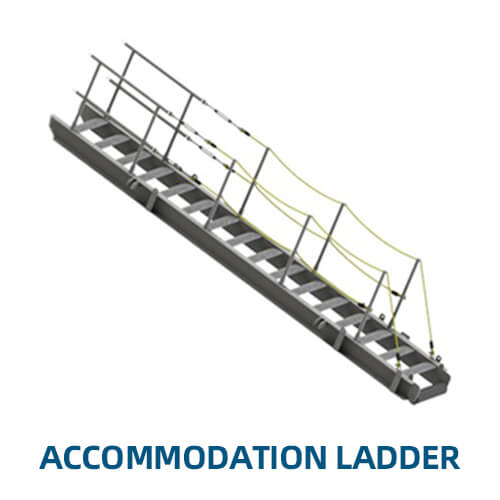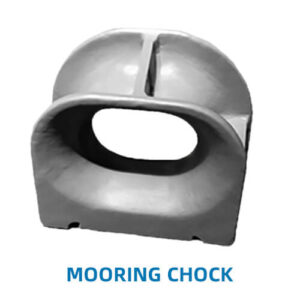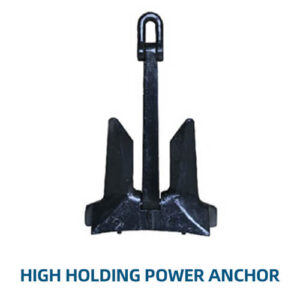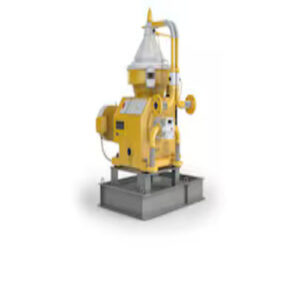Key Features of an Accommodation Ladder:
- Construction and Materials:
- Durable Materials: Accommodation ladders are typically constructed from robust materials such as marine-grade aluminum or steel to withstand the harsh maritime environment. The materials are often coated with anti-corrosive treatments to resist rust and corrosion caused by exposure to saltwater.
- Anti-Slip Steps: The steps of the ladder are equipped with anti-slip surfaces to prevent slipping, even when wet. These surfaces are often made from materials like non-skid rubber or grooved metal.
- Guardrails and Handrails: To ensure safety, accommodation ladders are fitted with guardrails or handrails on both sides. These rails provide support and stability to those using the ladder and are often made from the same durable materials as the ladder itself.
- Design and Functionality:
- Adjustable Length: Accommodation ladders are designed to be adjustable in length to accommodate various heights between the ship’s deck and the quay or a small boat. This adjustability ensures that the ladder can be used in different tidal conditions and on vessels of various sizes.
- Inclined Design: The ladder is inclined at an angle, making it easier to ascend or descend compared to a vertical ladder. The angle of inclination can usually be adjusted to suit different situations.
- Sturdy Platform: At the bottom of the ladder, a small platform may be provided to offer a stable footing when boarding or leaving the ladder. This platform is particularly useful when the ladder is used for disembarkation onto a moving boat.
- Safety Features:
- Safety Netting: In some cases, accommodation ladders are equipped with safety netting underneath or around the ladder. This netting is designed to catch any person who might accidentally fall, providing an additional layer of safety.
- Self-Leveling Steps: Some advanced models feature self-leveling steps that automatically adjust to maintain a horizontal surface, regardless of the ladder’s angle. This feature enhances safety by ensuring that the steps remain stable and easy to use.
- Emergency Release Mechanism: Many accommodation ladders are fitted with an emergency release mechanism that allows for quick detachment in case of an emergency, such as the need to rapidly move the ship.
- Applications:
- Crew and Passenger Access: The primary use of accommodation ladders is to facilitate the safe transfer of crew members and passengers between the ship and the dock or a small boat. This is particularly important in ports where the ship cannot dock directly alongside the quay.
- Pilot Boarding: Pilots, who guide ships through difficult navigational areas, often use accommodation ladders to board the vessel from a pilot boat.
- Emergency Evacuation: In emergency situations, such as a ship needing to be evacuated, accommodation ladders provide a reliable means for crew and passengers to leave the vessel safely.
- Installation and Operation:
- Securing Mechanisms: The ladder is securely attached to the ship using strong brackets or hinges that are capable of supporting the weight of the ladder and its users. These securing mechanisms are designed to be easy to deploy and retract, facilitating quick and efficient operation.
- Winches and Cranes: Some larger vessels use winches or cranes to deploy and retrieve accommodation ladders, particularly when the ladder is heavy or when it needs to be raised and lowered frequently.
- Compliance and Standards:
- Regulatory Compliance: Accommodation ladders must comply with international maritime safety regulations, such as those set by the International Maritime Organization (IMO) and the International Convention for the Safety of Life at Sea (SOLAS). These regulations dictate the design, construction, and maintenance standards that ensure the ladder’s safety and reliability.
- Regular Inspections: Regular inspections and maintenance are required to ensure that the ladder remains in good working condition. This includes checking for corrosion, ensuring that the steps and rails are secure, and verifying that any moving parts, like hinges and winches, are functioning correctly.
Advantages of an Accommodation Ladder:
- Safe and Reliable Access: Provides a secure means of access between the ship and the dock or other vessels, essential for the safety of crew and passengers.
- Durability: Built to withstand the challenging maritime environment, ensuring long-lasting performance.
- Flexibility: Adjustable design allows the ladder to be used in a variety of conditions, accommodating different water levels and ship heights.
Considerations When Using an Accommodation Ladder:
- Proper Deployment: Ensuring that the ladder is correctly deployed and secured is vital to prevent accidents. This includes adjusting the angle of inclination appropriately and verifying that the ladder is stable.
- Environmental Conditions: The ladder’s use may be affected by environmental conditions such as high winds, rough seas, or significant tidal changes. In such cases, additional precautions may be necessary to ensure safety.
- Maintenance: Regular maintenance is crucial to ensure the ladder’s safety and functionality. This includes checking for signs of wear, corrosion, and ensuring that all moving parts are lubricated and operational.
An Accommodation Ladder is an indispensable piece of equipment on ships, providing safe and reliable access for crew and passengers. Designed to be durable, adjustable, and compliant with international safety standards, these ladders are essential for the day-to-day operations of vessels in ports and at sea. Whether used for boarding pilots, facilitating crew transfers, or providing emergency egress, accommodation ladders play a vital role in ensuring the safety and efficiency of maritime activities.









